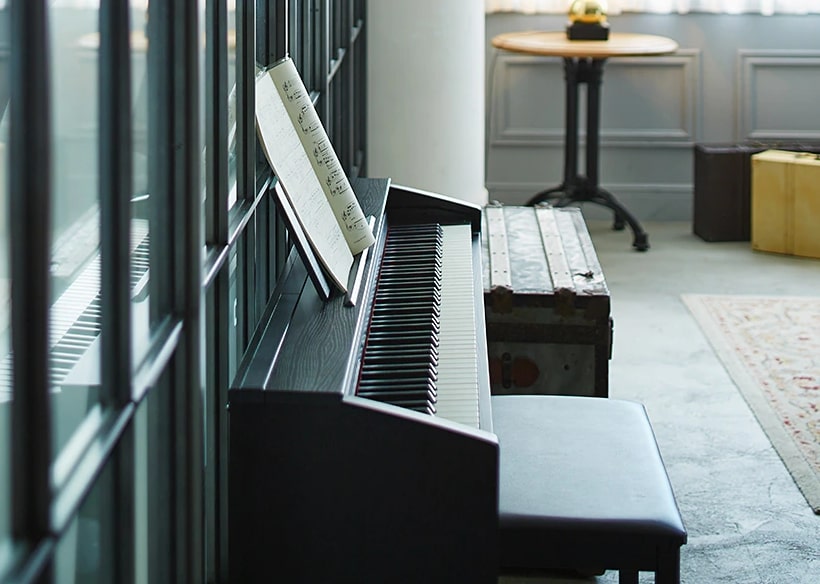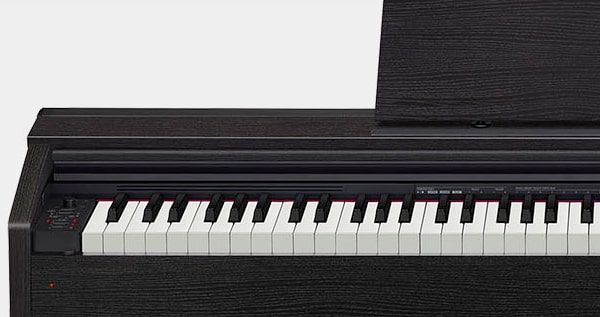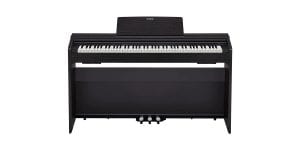The PX-870 is the successor of the PX 860 model of the Casio Pianos and belongs to the flagship Privia series from the brand. The piano is spotted in a modern cabinet design with three-pedal systems. Every single feature of this piano seems to be an improvisation over the other models of the Casio, starting from its keys to its sounds and the speaker system. Let us discuss the best features and the top specs of this piano here.
Casio PX-870 Piano Review 2024
Quick Opinion by Larry
It’s Worth Every Penny! The feel and sound of this piano are just awesome. The keys are weighted so perfectly that it feels like a real luxury piano. A perfect choice for beginners and intermediates looking to buy a quality budget piano.
Specifications of the PX-870
- Classy-looking piano with excellent sound and amplification features.
- Compact and space-saving piano, good enough for small apartments.
- Tri-sensor hammer action II keyboard with 88 fully weighted keys.
- Multi-dimensional AiR sound morphing technology.
- 60 preset songs with 19 in-built instrument sounds.
- 256 note polyphony with the acoustic simulator, damper resonance, and hammer response features.
- Ability to self-practice with lesson mode capability.
- Excellent speakers and ample connectivity features.
Pros & Cons of the Casio PX-870
What’s Best in Casio PX-870?
- The piano though is not a portable model, comes in a slim design with a stylish wooden finish.
- There is a three-pedal system that mimics the acoustic pianos and helps in creating music of high quality.
- Many built-in sounds enhance the quality of the music produced.
- 40W sound projection speaker system that can fill a hall without external speakers
- Built-in audio and MIDI recorder.
What’s Lacking in Casio PX-870?
- There is no screen to display the functions.
- The keys are not built that great, and thus could be a little noisier compared with other pianos of this price range.
- You cannot transport this piano for all your stage shows that easily.
The Outer Design of the Casio PX- 870
This PX-870 is not a lightweight model and is not designed for carrying out of your home frequently for your performances. It is a furniture-style piano that weighs about 75 pounds with three-pedal systems. But it stays compact and takes very little space in your living room. It features a stylish design and adapts to all home environments. The parts of this piano do not come pre-assembled, but you can easily fix them by reading the manual and spending an hour of your time.

The cabinet is smaller in height and has fewer seams, thanks to the improvisations from Casio. It features a nice wooden texture as it is made up of fiberboard pressed wood. There is a narrow speaker grill, a projection of the improvised speaker system, on par with the opened lid of the acoustic pianos. There are three pedals at the bottom of the cabinet, sustain, soft, and sostenuto and the sustain pedal supports half-pedal action as well.
The keys are protected from dust with the help of the pull-out keyboard cover. The piano is available in both white and black finishes. The entire control panel exists at the left end of the piano, rendering it a neat and uncluttered look. There are just eight buttons for the sounds and functions and you can access a number of functions with key+function action. There is no display and you only get a beep sound when to change the functions.
Check out: Best Digital Pianos in the Market
The Keys – From Where the Magic Begins

As we know, the entire Privia series from Casio features the tri-sensor hammer action keyboard in a scaled fashion. The 88 full-sized keys make use of actual hammers so as to recreate the feel of the acoustic piano. Their triple sensor detection system helps with a responsive playing experience with a faster repetition of notes. The graded keyboard is touch-sensitive with three preset settings to choose from. The keys have ebony and ivory texturing on top of them to prevent sweaty fingers from spoiling the notes.
The Piano Sounds and its Effects
With the PX-870 you can be sure of some high-quality sound, as it makes use of the AiR sound source multi-dimensional morphing technology. It will help professional pianists and music composers with rich sound at excellent accuracy with its lossless audio compression feature. Also, the PX-870 features a four-layer piano tone that is smooth, rich, and natural.
This piano features about 19 built-in songs that pertain to grand pianos, electric pianos, organs, harpsichords, strings, bass, vibraphone, etc. It makes use of the string resonance system that helps in simulating resonance for each of its 88 keys. The pianist is also able to adjust the string resonance according to their taste with the four settings available, pertaining to sound suppression and reverberation.
Yet another unique feature of this piano is the lid simulator, which alters sounds associated with the lid opening and closing of the grand acoustic pianos. One important feature that is available only with the PX-870 is the Key off simulator. This function helps in altering the tone of the piano sound based on how fast the fingers manipulate the keys. Thus, slower key release products have longer reverberation and vice versa.
The pianist can also customize the hammer response setting to define the time deviation between the keypress and the actual sound. With the help of the hall simulator functionality, you can recreate the acoustics of different performance venues such as a standard hall, French cathedral, auditorium, etc.
The PX 870 has 256-note polyphony, which is great for a piano of this price range. You can easily attempt even the complex of music pieces with this polyphony range. The piano has a 40W sound projection system with the help of its four speakers. The sound comes from different angles in its piano, and it sounds as loud as the acoustic piano, with a realistic experience. You can easily fill a medium-sized hall with quality music without accessing any external speakers.
Play Modes and Recording Features
Apart from the usual split mode, dual-mode and layer mode that we usually find in all pianos from Casio, the PX-870 grabs in a unique feature termed the concert play. With this, you can play along with a live orchestra with actual recordings. It sounds extremely realistic and beautiful and actually does magic with its present ten tunes.
There are about 60 songs stored in its music library. You can use them for practice and play along and you can also record your own MIDI songs and load up to ten of them in the internal memory of the piano. Most importantly, you can join websites like FreeMidi, Midiworld, etc, to download a number of songs and use them for your practice.
When it comes to recording features, there are actually two ways you are adept. The first option, as we all know is the MIDI recording. You can record two-track songs in MIDI format and play them separately, or together, or play along with one when you practice the other, in any combination as you prefer.
The second option is the Audio recording in the WAV format, and you can port them directly into the USB flash drive without making use of any equipment. Both the formats can be played directly from the flash drive, to listen to your own work, and make improvisations in it.
Connectivity Features of Casio PX-870
The PX-870 is known for its unique and exceptional connectivity features compared with the other digital pianos of this price point. The stereo jacks help to connect with headphones for uninterrupted practice. Alternatively, you can use the line-out jacks to connect the piano with external speakers.
There are no line-out jacks, but the USB port connects the piano with the computer to exchange files, preferably MIDI songs. You can also tap the advantages of music apps that are stored on your computer. The cable to connect the piano with the computer has to be bought separately by the user.
You can plug in a flash drive with the piano through the USB flash drive port to exchange files quickly. The Chordana app is also compatible with the PX-870 and you can make use of this app to control the different settings of the piano with the help of a virtual on-screen interface.
Related Reading: Best Digital Pianos for Advanced Pianist
Miscellaneous Functions
- There is a Volume Sync EQ control that works similar to the intelligent acoustic control from Yamaha.
- You can hamper the metronome function to adjust the tempo, volume, and time signatures of your song.
- You can alter the temperament of the piano between the 16 temperaments available
- The transpose function allows the pianist to alter the pitch of the keyboard,
- The tuning function helps in adjusting the pitch in 0.1 Hz steps. The octave shift function can be used to change the pitch in octave units.
Alternatives of Casio PX-870
Here are the top alternatives for the Casio PX-770 piano that you can buy from $1000 to $1500 price range.
- Yamaha YDP-144 Digital Piano
- Casio PX-770 Grand Piano
- Casio PX-S3000 Digital Piano
- Yamaha P515 Digital Piano
Final Verdict on Casio PX-870
The PX-870 is one of the best and the finest pianos for those looking for a piano for under $1000. It carries with it a number of features and improvements which are generally found on high-end pianos at a higher price point. You will find this piano the closest offspring of an acoustic piano in terms of touch and sound. The piano makes use of the highest quality samples from a grand concert piano and helps the pianist in crafting the finest music with keen detailing of intricate nuances.

